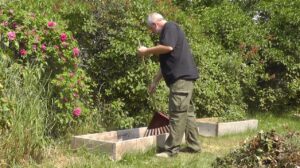If you hate digging and turning your compost, then lasagna gardening just might be the ticket for you. I’ve done it a little on a small bed, but this is the first year I’ve tried it on a larger bed (3’x10′).
The system wor ks by layering (hence the term lasagna) your browns and green, alternating each layer until you have a stack that’s way above the top of the bed.
ks by layering (hence the term lasagna) your browns and green, alternating each layer until you have a stack that’s way above the top of the bed.
You want to stack it as high as possible because settling is going to occur. And I mean a lot of settling. The first time I filled my bed, I went to the top of the wood frame. After about one month, the compost had broken down and settled to half its original size. Since I won’t be needing the bed until spring, I still have plenty of time to add more.
How to start your own lasagna bed
You want to make sure the weeds and grass do not grow up through the bed as you lay down the material to compost. If the ground is already bare you may be thinking about skipping this step. Don’t. The weeds will love you for feeding them and you’ll be fighting them for the rest of your life.
The first step is to lay down paper or cardboard. This will choke out any weed seeds. Once the paper is down, make sure you wet it. This will allow the paper to settle in the cracks and make good contact with the ground. You don’t want any air under the paper as this could let some weeds survive. The trick is to smother them.
Once the paper is laid, the easy part begins. Just start piling on the greens and browns. I always start with the browns (carbon). That way as the green material (nitrogen) breaks down, the liquid waste will be absorbed by the carbon waste.
Keep adding nitrogen and carbon about 6 inches thick each, alternating until you have a considerable pile. Remember, the pile will be about 1/4 its original size after it breaks down.
Leave it alone
Once the pile is at your desired height, you must leave it alone for at least a few months to let the magic work.
This is the beauty of lasagna gardening. There’s no work after piling the material on. Just walk away and come back in a few months to discover how wonderful things have been happening.
You will have to add more material after the growing season as this is just the nature of compost. It breaks down.
Find another spot in the yard and start another bed for next year.
Easy as pie (or lasagna)

